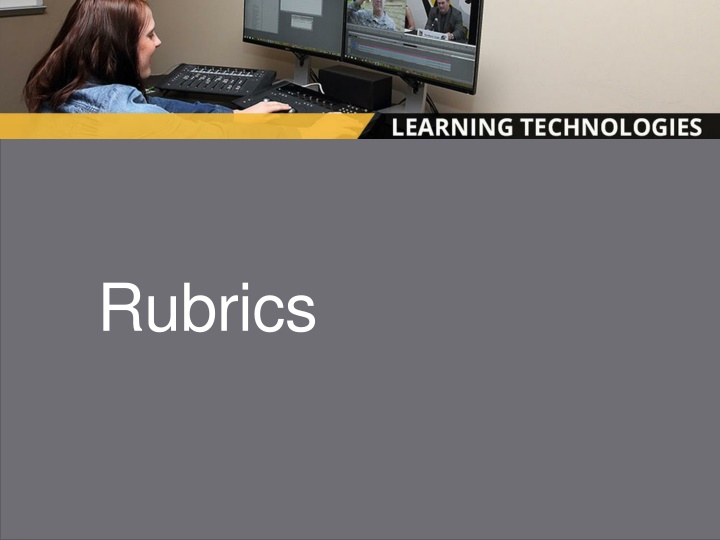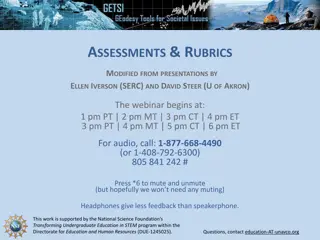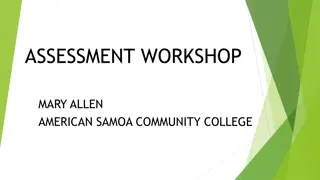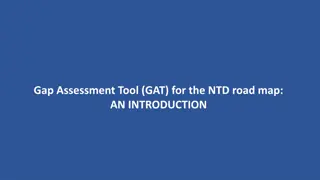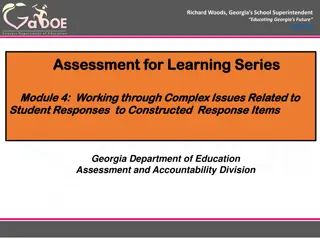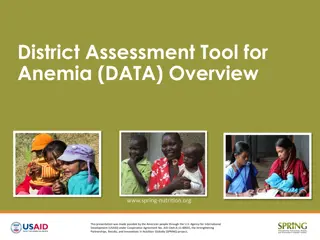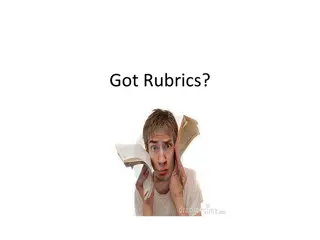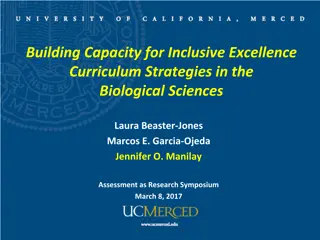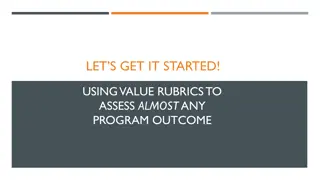Rubrics: A Tool for Effective Assessment
Rubrics are criterion-referenced rules for assessing student performance holistically or analytically. They provide detailed expectations for assignments, enable specific feedback, encourage critical thinking, and support fair assessment practices. Learn about the advantages of using rubrics and when to employ holistic versus analytic approaches.
Download Presentation

Please find below an Image/Link to download the presentation.
The content on the website is provided AS IS for your information and personal use only. It may not be sold, licensed, or shared on other websites without obtaining consent from the author.If you encounter any issues during the download, it is possible that the publisher has removed the file from their server.
You are allowed to download the files provided on this website for personal or commercial use, subject to the condition that they are used lawfully. All files are the property of their respective owners.
The content on the website is provided AS IS for your information and personal use only. It may not be sold, licensed, or shared on other websites without obtaining consent from the author.
E N D
Presentation Transcript
Definition of a Rubric Rubrics are criterion-referenced rules for assessing student performance holistically or analytically (on different dimensions). A scoring tool that lays out the specific expectations for an assignment, providing a detailed description of what constitutes acceptable or unacceptable levels of performance. (Stevens & Levi, 2005).
Have you ever had a student look at you like this when you are trying to explain an assignment?
Consider developing a Rubric ! Here are some advantages of a Rubric Provides timely and specific feedback Prepares students to use detailed feedback Encourages critical thinking Facilitates communication of expectations Helps refine teaching methods Levels the playing field
Rubrics can also help Students to Self-assess Provide examples of work corresponding to different levels Provide coaching on components of quality before the whole assignment is undertaken Have students use the rubric to assess each other s practice assignments and develop norms of fairness Have students use the rubric to assess their own work and provide feedback on their self-assessment
When to use Holistic and Analytic Rubrics BU.edu 01.06.16
Advantages and Disadvantages of Holistic Rubrics Advantages of Holistic Rubrics Emphasis on what the learner is able to demonstrate, rather than what s/he cannot do. Saves time by minimizing the number of decisions raters make. Can be applied consistently by trained raters increasing reliability. Disadvantages of Holistic Rubrics Does not provide specific feedback for improvement. When student work is at varying levels spanning the criteria points it can be difficult to select the single best description. Criteria cannot be weighted.
Advantages and Disadvantages of Analytic Rubrics Advantages of Analytic Rubrics Provide useful feedback on areas of strength and weakness. Criterion can be weighted to reflect the relative importance of each dimension. Disadvantages of Analytic Rubrics Takes more time to create and use than a holistic rubric. Unless each point for each criterion is well-defined raters may not arrive at the same score
Analytic Rubric Oral Communication Descriptor Exemplary Competent Developing Content Full understanding of topic Good Understanding of parts of topic Does not seem to understand topic Stays on topic Stays on topic Stays on topic 94-75-% if the time It was hard to tell what the topic was 100-95% if the time Preparedness Completely prepared and has obviously rehearsed Somewhat prepared, but it is clear that rehearsal was lacking Does not seem at all prepared to present Eye contact Establishes eye contact with everyone in the room Sometimes establishes eye contact Does not look at people during the presentation
Application of Scales Exemplary, proficient, marginal, unacceptable Advanced, intermediate high, intermediate, novice Distinguished, proficient, intermediate, novice Accomplished, average, developing, beginning Outstanding, very good, good, poor, unsatisfactory A, B, C, D, F Satisfactory, unsatisfactory
Remember - questions to consider What should the assignment include? What will be assessed? How will the assignment align with standards? How will we measure student achievement?
Rubric Template (Describe here the task or performance that this rubric is designed to evaluate.) Beginning 1 Developing 2 Description of identifiable performance characteristics reflecting development and movement toward mastery of performance. Description of identifiable performance characteristics reflecting development and movement toward mastery of performance. Description of identifiable performance characteristics reflecting development and movement toward mastery of performance. Description of identifiable performance characteristics reflecting development and movement toward mastery of performance. Accomplished 3 Exemplary 4 Score Description of identifiable performance characteristics reflecting a beginning level of performance. Description of identifiable performance characteristics reflecting the highest level of performance. Stated Objective or Performance Description of identifiable performance characteristics reflecting mastery of performance. Description of identifiable performance characteristics reflecting a beginning level of performance. Description of identifiable performance characteristics reflecting the highest level of performance. Stated Objective or Performance Description of identifiable performance characteristics reflecting mastery of performance. Description of identifiable performance characteristics reflecting a beginning level of performance. Description of identifiable performance characteristics reflecting the highest level of performance. Stated Objective or Performance Description of identifiable performance characteristics reflecting mastery of performance. Description of identifiable performance characteristics reflecting a beginning level of performance. Description of identifiable performance characteristics reflecting the highest level of performance. Stated Objective or Performance Description of identifiable performance characteristics reflecting mastery of performance.
Resources AACU 16 VALUE Rubrics for the LEAP Essential Learning Outcomes. http://www.aacu.org/value/rubrics FHSU Blackboard Tutorial. www.fhsu.edu/learningtechnologies/BlackboardFacultyTuto rialAssessment/ Bb Rubrics Tutorial Handouts www.fhsu.edu/uploadedFiles/Technology/ctelt/Documents/R ubrics%20Handout.pdf University of Central Florida - http://www.fctl.ucf.edu/teachingandlearningresources/cours edesign/assessment/assessmenttoolsresources/rubrics.php Cornell University - http://www.cte.cornell.edu/teaching- ideas/assessing-student-learning/using-rubrics.html Michigan State University - http://fod.msu.edu/oir/rubrics
